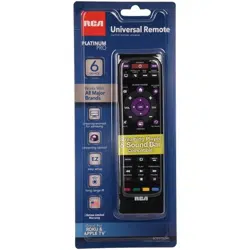Documents: Go to download!
User Manual
- User Manual - (English)
- Code List - (English)
- Install batteries
- Program the remote
- Program Your Preset Channels
- Tour of the Remote
- Advanced Functions
- Troubleshooting
- Care and Maintenance
Table of contents
RCA RCRPS06GR Owners Manual
Install batteries
Your universal remote requires two AAA alkaline batteries (not included).
To install the batteries:
-815686.png)
1. Remove the battery compartment cover.
2. Insert the batteries, matching the (+) and (–) marks inside the battery compartment.
3. Push the battery cover back into place.
Battery Precautions:
• Do not mix old and new batteries.
• Do not mix alkaline, standard (carbon-zinc) or rechargeable (nickel-cadmium) batteries.
• Always remove old, weak or worn-out batteries promptly and recycle or dispose of them in accordance with Local and National Regulations.
Battery Saver
Your universal remote control saves battery power by automatically turning off if any key is pressed for more than 60 seconds. This saves your battery life should your remote get stuck in a place where the keys remain depressed, such as between sofa cushions.
Tip: This remote is already programmed to operate many Samsung-branded TVs and DVD players, DIRECTV-branded satellite receivers, and Sony-branded audio receivers. Just press the corresponding key— DVD for a DVD player, TV for a television, SAT•CBL•STREAM for a satellite receiver, and AUDIO for an audio receiver.
Program the remote
To use this universal remote with your home entertainment system, first you need to program it to control your devices. There are four ways you can program the universal remote to operate your devices:
• The Brand Code Search searches through the codes for select brands of devices. If your brand is listed in the Brand Code section of the code list, try this method first.
• The Direct Code Entry searches through the codes for select brands of devices. Note: Direct Code Entry is usually the best method to use for audio devices.
• The Auto Code Search goes automatically through all the codes for the device you’re trying to control.
• The Manual Code Search lets you manually go through all the codes for the device you’re trying to control.
Brand Code Search
The Brand Code Search goes through only the codes for one of the select brands listed in the accompanying code list. If your brand of device is listed, this search can be very quick and easy.
IMPORTANT: The Brand Code Search works for TVs, VCRs, DVD players, satellite receivers, cable boxes, and audio devices. The Brand Code Search does not work for programming this remote to control DVRs, digital TV converter boxes, or streaming media players. Use a different programming method for these kinds of devices.
TIPS:
Each device key is associated with a type of device—the TV is preset to search for TVs, SAT•CBL•STREAM for satellite receivers, digital TV converters, cable boxes, or streaming media players, DVD for DVD players, DVR•AUX1 for DVRs, VCR•AUX2 for VCRs, and AUDIO for audio receivers.
To program the DVR•AUX1 or VCR•AUX2 key for a different type of device, see the Reassigning the DVR•AUX1 or VCR•AUX2 Key section. To control combo devices, like TV/DVDs and TV/ VCRs, you need to program each key separately. Each key will control that part of the combo device.
If the original remote control that came with your device has separate ON and OFF keys (instead of a single POWER key), the Brand Code Search might not work with that device. Try the Direct Code Entry method described later in this manual.
To exit without saving a new code at any point in the Brand Code Search, press the EXIT•BACK key.
1. Manually turn on the device you want to control.
-179780.png)
2. Find your device’s brand in the Brand Code list section of the accompanying code list. Circle the number for your brand and keep the list handy.
-246462.png)
3. Press and hold the device key you want to program (the POWER key illuminates). While you’re holding down the device key, use your other hand to press and hold the remote’s POWER key at the same time (the POWER key turns off).
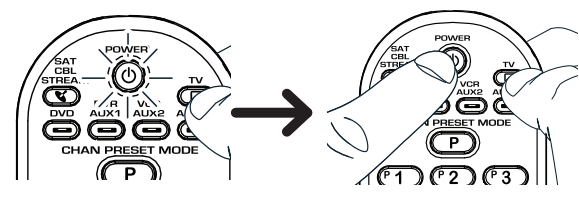
4. Wait until the POWER key comes on and stays on. Then release both keys.
5. Look at the numbers you circled for your device’s brand code. Press those numbers on the remote keypad. Note: For single-digit brand codes, press the 0 key first (for example, 0-5 for 5).
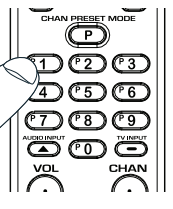
6. Point the remote directly at the front panel of the device you want to control. Press GUIDE on the remote and wait 2 seconds. The remote is sending a single code for your device’s brand.
-456927.png)
Did your device turn off?
YES: Press the remote’s POWER key to turn your device back on. Then test all of the following remote keys that your device uses: VOL+, CH+, 0 digits, PLAY, and STOP. If these keys work, press OK/ENTER. If they don’t, repeat this step until your device turns off again.
NO: Press GUIDE again. The remote sends the next code for your brand. Keep pressing GUIDE every 2 seconds until your device turns off. When it does, press OK/ ENTER
NOTES:
Throughout the programming of each key, be sure to keep the remote pointed at the IR sensor of the device you are currently programming the remote to control.
Test the remote with the device to make sure the device key is programmed with the correct code for maximum functionality. If some features don’t work, try a different code. See the “Testing the Code for Maximum Functionality” section below for more information.
During the Brand Code Search, the remote ignores keypresses that aren’t part of the search.
The search times out after two minutes (the POWER key blinks four times and the last programmed code under that device key is retained).
The POWER key blinks four times when the remote has gone through all the codes. The remote exits the Brand Code Search. If your device hasn’t turned off yet, try a different search method
Testing the Code for Maximum Functionality
- Try a variety of the device’s functions with the remote. If some device features don’t work, go to the next step to try a different code.
- Repeat the Brand Code Search from the beginning. When the device turns off for the first time, don’t press the OK/ENTER key, which would store the same code. Instead, with the unit now off, continue to press the GUIDE key repeatedly until the unit turns back on.
- Once the unit turns back on, you have found another code that operates the device. Press the OK/ENTER key.
- Test the key’s functionality again by attempting to control a variety of the device’s functions. If the code that has been stored controls the majority of the device’s functions, programming is complete. If the code stored does not give maximum functionality, try another code.
Direct Code Entry
Direct Code Entry lets you enter a code from the accompanying code list for your brand of device.
TIPS:
Each device key is associated with a type of device—the TV is preset to search for TVs, SAT•CBL•STREAM for satellite receivers, digital TV converters, cable boxes, and streaming media players, DVD for DVD players, DVR•AUX1 for DVRs, VCR•AUX2 for VCRs, and AUDIO for audio receivers.
To program the DVR•AUX1 or VCR•AUX2 key for a different type of device, see the Reassigning the DVR•AUX1 or VCR•AUX2 Key section.
To control combo devices, like TV/DVDs and TV/VCRs, you need to program each key separately. Each key will control that part of the combo device.
1. Manually turn on the device you want to control.
-874400.png)
2. Find the Code List that came with the remote. Locate the section for the type of device you’re trying to program, and find your brand in that section. Circle the codes for your brand and keep them handy.
-926248.png)
3. Press and hold the device key you want to program (the POWER key comes on). While you’re holding down the device key, use your other hand enter the first five-digit code for your brand in the code list (the POWER key goes off after the first digit).

4. When you’ve finished entering the five-digit code, keep holding down the device key and look at the POWER key.
Is the POWER key illuminated?
YES: You’re done! You’ve programmed this device key.
NO, it blinked four times and turned off: You have either entered a code number that is not in the code lists or missed a step in the code entry procedure. Try step 3 again.
NOTES:
Test the remote with the device to make sure the device key is programmed with the correct code for maximum functionality. If some features don’t work, try a different code in the list.
Remember to enter the code for future reference in the box provided in the Code Retrieval section of this manual.
If your brand isn’t listed in the code list, use one of the Code Search methods to program the remote control. (Refer to the Auto and Manual Code Search methods.)
If you release the device key any time during the Direct Code Entry procedure, the POWER key blinks four times and the process is exited. The last programmed code under the device key is retained.
Auto Code Search
The Auto Code Search goes automatically through all the codes for the device you’re trying to control. When you fi nd the one that operates your device, you can stop the search and store that code.
TIPS:
Each device key is associated with a type of device—the TV is preset to search for TVs, SAT•CBL•STREAM for satellite receivers, digital TV converters, cable boxes, and streaming media players, DVD for DVD players, DVR•AUX1 for DVRs, VCR•AUX2 for VCRs, and AUDIO for audio receivers.
To program the DVR•AUX1 or VCR•AUX2 key for a different type of device, see the Reassigning the DVR•AUX1 or VCR•AUX2 Key section.
To control combo devices, like TV/DVDs and TV/ VCRs, you need to program each key separately. Each key will control that part of the combo device.
If the original remote control that came with your device has separate ON and OFF keys (instead of a single POWER key), the Auto Code Search might not work with that device. Try the Direct Code Entry method described in this manual.
To exit without saving a new code at any point in the Auto Code Search, press the EXIT•BACK key.
1. Manually turn on the device you want to control.
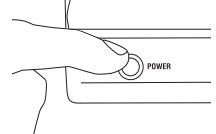
2. Press and hold the device key you want to program (the POWER key illuminates). While you’re holding down the device key, use your other hand to press and hold the remote’s POWER key at the same time (the POWER key turns off).

3. Wait until the POWER key comes on and stays on. Then release both keys.
4. Point the remote directly at the front panel of the device you want to control. Press SLOW on the remote and wait 5 seconds. The remote is sending a batch of 10 codes on your device.

Did your device turn off?
YES: Go to step 5.
NO: Press SLOW again. The remote sends the next batch of 10 codes.
Keep pressing SLOW every 5 seconds until your device turns off.
5. When your device turns off, press the SKIP BACK key on the remote and wait at least 2 seconds. The remote tries the last of the previous ten codes.

Did your device turn on?
YES: Test all of the following remote keys that your device uses: VOL+, CH+, 0 digit, PLAY, and STOP. If these keys work, press OK/ENTER. If they don’t, repeat this step until your device turns off again.
NO: Press SKIP BACK again. The remote sends the next code in the batch.
Keep pressing SKIP BACK every 2 seconds until your device turns back on. When it does, press OK/ENTER.
Note: If you accidentally press the SKIP BACK key after your device turns on, press the SKIP FWD key. Then, wait two seconds to see if your device turns off again.
NOTES:
Throughout the programming of each key, be sure to keep the remote pointed at the IR sensor of the device you are currently programming the remote to control.
Test the remote with the device to make sure the device key is programmed with the correct code for maximum functionality. If some features don’t work, try a different code. See the “Testing the Code for Maximum Functionality” section below for more information.
During the Auto Code Search, the remote ignores key presses that aren’t part of the search.
The search times out after two minutes (the POWER key blinks four times and the last programmed code under that device key is retained).
The POWER key blinks four times when the remote has gone through all the codes. The remote exits the Auto Code Search. If your device hasn’t turned off yet, try a different search method.
Testing the Code for Maximum Functionality
1. Try a variety of the device’s functions with the remote. If some device features don’t work, go to the next step to try a different code.
2. Repeat the Auto Code Search Method from the beginning. When your device turns off, do not stop searching. Instead, with the unit now off, continue to press the SLOW key every 5 seconds until the unit turns back on.
3. Once the unit turns back on, press the SKIP BACK key on the remote every 2 seconds until your device turns off again. When your device turns off again, press the OK/ENTER key.
4. Test the key’s functionality again by attempting to control a variety of the device’s functions. If the code that has been stored controls the majority of the device’s functions, programming is complete.
If the code stored does not give maximum functionality, try another code.
Manual Code Search
The Manual Code Search takes you one by one through all the codes for the device you’re trying to control. When you find the one that operates your device, you stop the search and store that code.
TIPS:
The Manual Code Search method may take a long time because the remote searches through all of the codes in its memory one by one. If your brand is listed in the Brand Codes or the Code Lists, first try the Brand Code Search or the Direct Code Entry method.
Each device key is associated with a type of device—the TV is preset to search for TVs, SAT•CBL•STREAM for satellite receivers, digital TV converters, cable boxes, or streaming media players, DVD for DVD players, DVR•AUX1 for DVRs, VCR•AUX2 for VCRs, and AUDIO for audio receivers.
To program the DVR•AUX1 or VCR•AUX2 key for a different type of device, see the Reassigning the DVR•AUX1 or VCR•AUX2 Key section.
To control combo devices, like TV/DVDs and TV/ VCRs, you need to program each key separately. Each key will control that part of the combo device.
To exit without saving a new code at any point in the Manual Code Search, press the EXIT•BACK key
1. Manually turn on the device you want to control.
-82819.png)
2. Press and hold the device key you want to program (the POWER key illuminates). While you’re holding down the device key, use your other hand to press and hold the remote’s POWER key at the same time (the POWER key turns off).

3. Wait until the remote’s POWER key comes on and stays on. Then release both keys.
4. Point the remote directly at the front panel of the device you want to control. Press SKIP FWD on the remote and wait 2 seconds. The remote is sending a single code for your device.
-486293.png)
Did your device turn off?
YES: Press the remote’s POWER key to turn your device back on. Then test all of the following remote keys that your device uses: VOL+, CH+, 0 digit, PLAY, and STOP. If these keys work, press OK/ENTER. If they don’t, repeat this step until your device turns off again.
NO: Press SKIP FWD again. The remote sends the next code for your device.
Keep pressing SKIP FWD every 2 seconds until your device turns off. When it does, press OK/ENTER.
TIP: Because there are so many codes, you may have to press the SKIP FWD key many times possibly hundreds of times.
NOTES: Throughout the programming of each key, keep the remote pointed at the device you are programming the remote to control.
Test the remote with the device to make sure the device key is programmed with the correct code for maximum functionality. If some features don’t work, try a different code. See the “Testing the Code for Maximum Functionality” section below for more information.
During the Manual Code Search, the remote ignores keypresses that aren’t part of the search. The search times out after two minutes (the POWER key blinks four times and the last programmed code under that device key is retained).
The POWER key blinks four times when the remote has gone through all the codes. The remote exits the Manual Code Search. If your device hasn’t turned off yet, try a different search method.
Testing the Code for Maximum Functionality
1. Try a variety of the device’s functions with the remote. If some features of your devices don’t work, go to the next step to try a different code.
2. Repeat the Manual Code Search and Entry Method from the beginning. When the device turns off for the fi rst time, don’t press the OK/ ENTER key, which would store the same code. Instead, with the unit now off, continue to press the SKIP FWD key repeatedly until the unit turns back on.
3. Once the unit turns back on, you have found another code that operates the device. Press the OK/ENTER key.
4. Test the key’s functionality again by trying a variety of functions. If the code controls the majority of the device’s functions, programming is complete. If the code stored does not give maximum functionality, try another code.
Program Your Preset Channels
This remote control gives you access to up to 10 of your favorite satellite/cable and TV channels instantly, using the Preset Keys. For example, if one of your favorite channels is ESPN, you can set up this remote to take you directly to that channel when you press the P key followed by the 1 key.
To use the Preset Channels feature, first you must program the channel you’d like to use for each Preset key. Before you start, use the following table to gather information about your favorite channels. You can set up 10 favorites for each channel source: 10 for SAT/CBL/STREAM and 10 for TV.
Use this example table as a guide:
-107350.png)
-992024.png)
NOTES:
• Preset channels can be set up for satellite receivers, cable boxes, and digital TV converters (if you’ve programmed the SAT•CBL•STREAM key to operate that kind of device). Streaming players do not have preset channel capability.
• Set up all satellite, cable, or digital converter box preset channels first. Then set up your TV channels. Jumping back and forth between them might get confusing.
To program your Preset Channels:
1. Press and hold the P key. The Power key illuminates. Continue to hold for three seconds until you see a blink of the Power key LED. The light remains illuminated and now you can release the P key.

2. Press the 1 key to program your first preset channel. The POWER key flashes once and stays on.
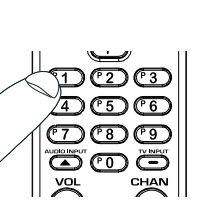
3. Press the device key listed for this channel (TV or SAT•CBL•STREAM).

NOTE: The device key you press in step 3 must be programmed to control your device in order for this preset channel to work. See the Programming the Remote section for information on programming these keys to control your devices.
4. Enter the channel number you wrote down for preset channel number 1 above. In the example, you would press 2, then 0, then 2. The POWER key light turns off.

5. When you’ve finished entering the channel number, press the P key to save your preset channel.

NOTE: If you’re programming a digital sub-channel (like 59.2), you need to press the TV INPUT / – key between the regular channel and the sub-channel (for example 5, then 9, then TV INPUT / –, then 2).
If you want to program more Preset Channels: Repeat steps 1 to 5 for the next Preset Channel.
If you’re finished programming your Preset Channels: Start using the remote normally
Preset Programming Notes
• To quit programming preset channels at any time, press the EXIT•BACK key. The POWER key fl ashes 4 times. No changes to the Preset keys are made.
• When you’re programming presets, the remote gives you a maximum of 15 seconds between key presses before it leaves programming mode and goes back to normal operation. The POWER key fl ashes 4 times—this means the remote has not saved your programmed presets and you’ll have to start again.
• During preset channel programming, the remote accepts only certain key presses: the P key, the number keys, and the device keys. If you press any other key on the remote during preset programming, the remote exits preset programming without saving your changes. The POWER key fl ashes 4 times. You will have to start programming again.
Using your Preset Channels
1. Press TV or SAT/CBL/ STREAM.

2. Press the P key. The POWER key lights up and stays on.
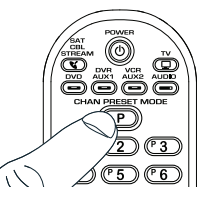
3. Press the number key for the preset channel you want to access. For example, if you want to go to the channel you programmed as preset channel 3, press 3. While the POWER key is illuminated, the remote is in preset mode. This means you can go straight to your preset channels--you don’t have to press the P key again. Preset mode lasts for 2 minutes after the last key press. Here’s how to use the remote in preset mode.

To go to another preset: Press the number for that preset channel.
To go to a channel that’s not a preset: Press the P key to exit preset mode. Then enter the channel number directly. (You can also use the CH + and CH - keys.)
To exit preset mode at any time: Press the P key.
Tour of the Remote
In most cases, the keys on this remote perform the same functions as the keys on your original remotes once you’ve programmed this remote to operate your components. Many keys on this remote have other functions as well.
Illuminated Power key serves as an indicator light to provide feedback.
Device keys (TV, SAT•CBL•STREAM, DVD, DVR•AUX1, VCR•AUX2, AUDIO) put the remote in the right mode to control your device.
CHAN PRESET MODE lets you program your favorite channels onto the preset (P) keys, then access them directly once programmed. AUDIO INPUT toggles between audio input signals.
The TV Input and – key toggles through the video inputs and when you’re entering digital channel numbers directly, this button lets you separate the main channel from the sub channel (such as 59.1).
Arrow keys act as navigation keys in device guides and menu systems.
OK/ENTER selects your menu choices. GUIDE and MENU put the remote in menu/ guide mode; they also access the same features as the keys on your original remotes.

The MACRO key, along with the number keys 1–8, let you store and execute multi-step actions (macros) in a single keypress Backlight key ( ) turns backlighting on/off. EXIT•BACK exits remote programming; it also performs the same functions as on your original remotes. In streaming players it will go back one menu screen.
IMPORTANT: Because this remote controls more than one device, you must fi rst “tell” the remote which device you wish to operate. That means, if you wish to operate your TV, you must fi rst press the TV key to put the remote in the TV Mode. The remote stays in that device mode until you press a different device key. For example, if your remote is in TV Mode and you want to operate the DVD player, you must press the DVD key to change device modes.
Backlighting
Backlight illumination helps you see the remote control keys better in the dark. You can turn backlight illumination on or off by pressing the backlight key ( ). Backlighting stays on as long as keys are being pressed and turns off four seconds after the last keypress. If the backlight illumination is on, and you press the backlight key, the backlight turns off.
Advanced Functions
Master Power
Each time you press the POWER key, this remote automatically turns on and off the devices you’ve programmed it to operate. This feature, called “Master Power” must be enabled by device.
Programming the Master Power Key
1. Press and hold the P key for 3 seconds until the LED indicator turns on and stays on.
2. Release the P key.
3. Press the device key you want to add to the power macro.
4. Press the CH + key and the LED blinks.
5. The LED stays on.
6. Follow steps 3 and 4 to add more devices to Master Power.
7. When all devices are added Press VOL + key to enable Master Power.
8. Press the P key to complete the process.
Note: To remove a device in above process use the CH - key.
To disable Master Power:
1. Press and hold the P key for 3 seconds. The POWER key comes on.
2. Press VOL- to disable Master Power.
3. Press the P key to confi rm. The POWER key now turns only the device you’re currently controlling on and off.
To enable Master Power again:
1. Press and hold the P key for 3 seconds. The POWER key comes on.
2. Press VOL+ to enable Master Power again.
3. Press the P key to confi rm. The Master Power function is enabled again.
Reassigning the DVR - AUX1 or VCR - AUX2 Key
The DVR•AUX1 key defaults to control a DVR, and the VCR•AUX2 key defaults to control a VCR. If you want the DVR•AUX1 or VCR•AUX2 key to control a different device (an additional TV, DVD, satellite or cable box, for example), you must reassign it.
1. Press and hold the DVR•AUX1 or VCR•AUX2 key. The POWER key turns on.
2. While holding down the DVR•AUX1 or VCR•AUX2 key, press and release the number key on the keypad for the device you wish to control (see the chart below). The POWER key turns off.

3. Release the DVR•AUX1 or VCR•AUX2 key. The POWER key blinks four times and then turns off. The DVR•AUX1 or VCR•AUX2 key is now set to control the device type you selected.
4. Follow the directions in the auto, brand, direct entry, or manual code search to program the DVR•AUX1 or VCR•AUX2 key.
Volume Punch-Through
Volume Punch-Through allows the VOL and MUTE keys, when pressed in SAT•CBL•STREAM, DVD, DVR•AUX1, or VCR•AUX2 modes, to “punch through” to either TV or AUDIO, whichever was accessed last. Volume Punch-Through occurs
automatically and allows you to control the volume without exiting the current mode. (If the DVR•AUX1 or VCR•AUX2 key has been programmed with a TV or AUDIO code, volume can punch through to this device as well.)
Note: Volume Punch-Through does not occur in cases where the component code has its own volume/mute controls, such as some satellite receivers.
Advanced Punch-Through
Volume punch-through as described above occurs automatically. Advanced punch-through lets you specify one device for all volume commands for each non-audio mode (SAT•CBL•STREAM, DVD, DVR•AUX1, or VCR•AUX2). You can specify either the TV or AUDIO device (or an AUX key operating a TV or audio device).
1. Press and hold the device key whose volume commands you want to send to the TV or audio device. The POWER key turns on.
2. While holding down the device key, press and hold the VOL + key. The POWER key turns off.
3. After holding down both keys for 3 seconds, the POWER key turns on and stays on. Release both keys.
4. Press the device key you want the Volume Punch-Through to be directed to from the selected mode (TV, AUDIO, or AUX key). The POWER key fl ashes.
Note: The device key pressed in step 4 must be programmed with a TV or AUDIO component. If an invalid key is pressed, the POWER key fl ashes four times, then turns off.
Important: Once you have programmed any device with a specifi ed Volume Punch-Through, the Volume Punch-Through for all other devices defaults to AUDIO. If you do not want other components’ Volume Punch-Through to default to AUDIO, you must manually program them, using steps 1-4.
Resetting Volume Punch-Through
You can reset volume punch-through to its default behavior (sending volume commands to either TV or AUDIO, whichever was pressed last).
1. Press and hold the device key whose volume punch-through functionality you want to reset to the original behavior. The POWER key turns on.
2. While holding down the device key, press and hold the VOL – key. The POWER key turns off.
3. After holding down both keys for 3 seconds, the POWER key turns on and stays on. Release both keys. The POWER key fl ashes, and the volume punch-through for this device is reset to the original behavior.
To reset volume punch-through for other devices, repeat the steps above for that device key.
Channel Lock
Channel lock automatically sends channel commands, like the CH, PREV CHAN, and 0–9 number keys, to your satellite receiver, cable box, or digital TV converter when you’re in TV mode. This can save you keypresses if you use a device other than your TV to change channels.
To turn channel lock on:
- Press and hold the device key for the device you use to change channels. While you’re holding down this device key, use your other hand to press and hold the remote’s CH + key at the same time.
- Wait until the remote’s POWER key comes on and stays on. Then release both keys.
- Press OK•ENTER to lock channel commands to this device.
To turn channel lock off:
- Press and hold the TV key. While you’re holding down the TV key, use your other hand to press and hold the remote’s CH – key at the same time.
- Wait until the remote’s POWER key comes on and stays on. Then release both keys.
- Press OK•ENTER to start changing channels with your TV.
NOTE: The Preset Channel feature works independently of Channel Lock feature. When using Preset Channel feature please follow the “Using Your Preset Channels” section of this user guide.
Code Retrieval
Once you’ve programmed the remote to control your devices, you may want to record the codes for future reference. If you used the Direct Code Entry method, this is easy. Just find the codes you entered and make a note of them in the boxes below. If you used one of the Code Search methods to program your remote or if you used the Direct Entry method but don’t remember the code, you will need to retrieve each device’s five-digit code. Retrieving the actual code and writing it down will save you time if you ever need to program the remote again. If the codes are recorded, you can use the Direct Entry method to reprogram your remote to control your devices, which is quick and easy
TIPS: All TV codes start with the number 1; all VCR and DVR codes start with the number 2; all DVD player codes, the number 3; all audio device codes, the number 4; and all satellite receiver, cable box, and digital TV converters, the number 5.
To exit the Code Retrieval Mode at any time, press the EXIT•BACK key.
If you press an invalid key during the Code Retrieval process, the remote will not respond. If you do not press a valid Code Retrieval key (TV, DVD, SAT•CBL•STREAM, DVR•AUX1, VCR•AUX2, AUDIO, INFO, EXIT•BACK), Code Retrieval times out after 15 seconds. The POWER key blinks four times, and then turns off.
1. Press and hold the device key (TV, DVD, SAT•CBL•STREAM, DVR•AUX1, VCR•AUX2, or AUDIO) whose code you wish to retrieve. The POWER key illuminates. Keep pressing the device key.
2. While holding the device key down, press and hold the P key. The POWER key illumination turns off. After holding down both keys for three seconds, it turns back on.
3. Release both keys. The POWER key remains illuminated.
4. Starting with the number 1 key, press and release each number key on the keypad in the following order: 1-9, then 0. The number that causes the POWER key to blink is the fi rst number of the code. As you fi nd each number of the code, write it down for future reference. Then start with the number 1 key again.
5. Repeat step 4 until you have retrieved all fi ve numbers in the code. After the fi fth number is retrieved, the POWER key blinks briefl y, then turns off.
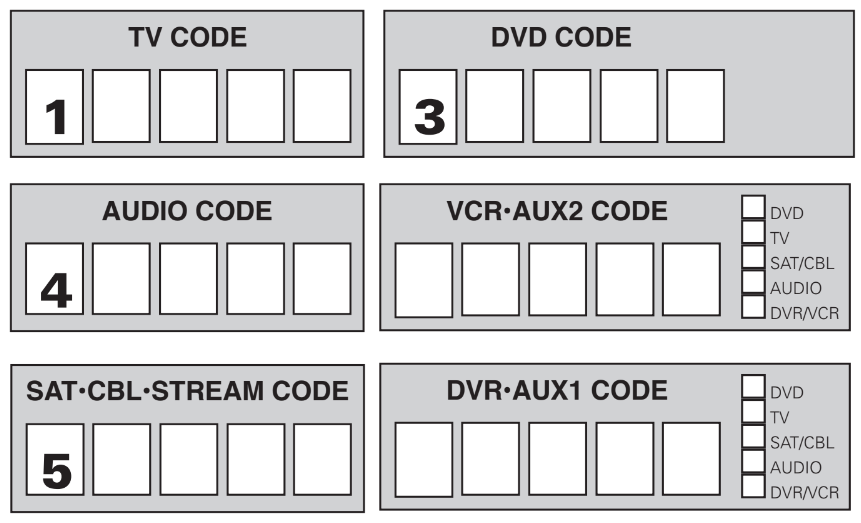
Learning
Codes from the Code Lists include basic functionality for each component they control. Once you have programmed in the code for your specific component, you can customize the universal remote to include certain functions from your original remote(s) that were not embedded in the preset code. Your universal remote has the ability to learn and store commands from your original remote(s) under the mode(s) of your choice. The universal remote can store up to 50 key commands.* Only one original remote can be learned under any one mode (e.g., the universal remote can learn commands for one TV remote, one VCR remote, etc.).
* Some learned signals require more memory than others. In these cases, fewer key commands can be learned.
Before First-Time Learning
Before you start learning keys for the fi rst time, clear any stored learning information that might be in the remote. This lets you begin with a clean slate.
1. Press and hold the EXIT•BACK key (the POWER key illuminates). While you’re holding down the EXIT•BACK key, use your other hand to press and hold the POWER key (the POWER key illumination turns off).
2. Wait until the POWER key comes on and stays on. Then release both keys. The remote is now in the Master Clear mode.
3. Press the OK / ENTER key to confi rm the Clear operation. The POWER key remains on for 2 seconds, then turns off. All Learned functions for all components are now cleared; all other programming remains intact.
Learning From Your Original Remotes
1. Place your original remote and the learning remote on a fl at surface as shown below. Point the top of your original remote at the top of the learning remote. The IR LED on the original remote should be pointing directly at the learning remote’s learning sensor, located on the top of the remote. The remotes should be 1–2 inches apart.

2. On the learning remote, press and hold the device key you want to use the learned function in (the POWER key turns on
and remains on). While holding down the device key, use your other hand to press and hold the RECORD key (the POWER key illumination turns off).
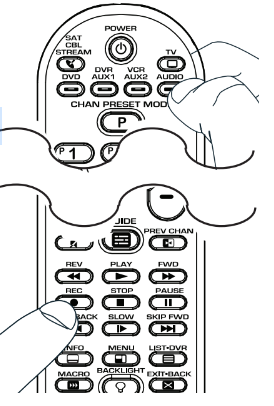
3. Wait until the POWER key turns on and stays on. Then release both keys. The remote is now in Learning mode.
4. On the learning remote, press the key you want to use for the learned function. The illuminated POWER key blinks once, then remains on.
5. On the original remote, press and hold the key you want to teach to the universal remote. Wait until the POWER key on the learning remote blinks once, then release the key on the original remote. The learning remote has fi nished learning this key.
Note: If a problem occurs during the Learning process, the illuminated POWER key blinks four times, but the unit remains in the Learning mode. If this occurs, adjust the distance between the remotes slightly and repeat from step 4.
6. To learn another key for this device mode: Repeat steps 4 and 5 for the key you want to learn.
To learn keys in a different device mode: Repeat steps 2–5 for the next device mode.
To save learned keys and exit learning: press any device key (like TV) on the learning remote.
Learning Tips
• Make sure the batteries in both the learning and original remote(s) are fresh.
• Incandescent or low-energy light can cause interference with IR transmissions. When using the Learning function, keep remotes at least three feet away from such light sources.
• Make sure the original remote is in the same mode as the universal remote so that the Learned key is assigned to the correct mode.
• You cannot learn any commands on the device, macro, exit, preset and backlight keys.
• If you use the VOL+/- keys to learn new functions, the volume control will not adjust the volume in the Volume Punch Through mode.• To exit the Learning mode press any device key.
• The remote exits Learning mode if it has run out of memory to store new learned keys.
• To ensure that your units are compatible and to increase your familiarity with the Learning process, experiment by learning two or three keys initially. Then, carry out a Master Clear before learning all the desired functions from your original remote.
Macros
The Macro feature lets you execute a sequence of commands with one keypress. Any sequence of commands that you regularly perform (up to a maximum of 15 per macro) can be stored as a Macro under one of the 1–8 number keys (up to 6 macros).
Programming a Macro
Important: Before you start, make sure your remote is programmed to control your devices and that you’ve learned all the keys you want to learn from your original remotes.
1. Press and hold the MACRO key until the POWER key turns on and remains on. The remote is now in Macro Programming mode.
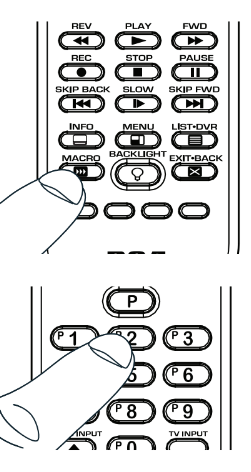
2. Press the number key (1–8) you want to use for this macro. The POWER key blinks once, then remains on.
Note: If you do not press a macro number key within 15 seconds (or if you press a macro number key that already has a macro programmed), the POWER key blinks four times and turns off. The remote exits macro programming mode, and no changes are made to existing Macros.
3. Press the device key for the fi rst device you use in the macro. The POWER key blinks once and remains on.
4. Press each key you want to use in this Macro, in the exact order the keys would be pressed if you were executing the sequence yourself. The POWER key blinks each time a key is pressed. Continue this process for all keys to be included in the Macro sequence under the given component mode.
Important: If you are using different devices in this macro, you must press each device key before you start pressing the keys for that device. For example, if you’re turning on the TV, then playing a DVD, you must press the TV key, then POWER, then DVD, then PLAY.
5. Once you are fi nished programming the Macro, press the MACRO key to save it. The POWER key illumination turns off, and the Macro is now ready to use.
Notes: To exit Macro programming at any time, press the EXIT•BACK key. The POWER key blinks four times, then turns off. No changes are made to existing Macros.
If you press a key that has a Learned function, the Learned function is assigned to the Macro sequence.
If you program all 15 keys into a Macro, the Macro is automatically saved after the 15th keypress.
The commands within a Macro must be programmed in sequential order. A delay of 0.5 seconds is used between sending each command in a programmed Macro sequence. You cannot program a Macro within a Macro.
Using a Macro
1. Press the MACRO key.
2. Press the number key assigned to the Macro sequence you want to execute. The POWER key blinks once, then remains on.
As the remote sends each command in the Macro sequence, the POWER key blinks once. After the remote sends the last command in the Macro sequence, the POWER key illumination turns off.
An Example Macro
This example shows an “all on” macro for a home theater with a TV, DVD player, and satellite
receiver.1. Press and hold the MACRO key until the POWER key turns on and remains on.
2. Press the 1 key to tell the remote where to store the macro.
3. Press the TV key to put the remote in TV mode.
4. Press the POWER key to turn the TV on.
5. Press the DVD key to put the remote in DVD mode.
6. Press the POWER key to turn on the DVD player.
7. Press the SAT•CBL•STREAM key to put the remote in that mode.
8. Press the POWER key to turn on the satellite receiver.
9. Press the MACRO key to save.
To execute the Macro, press the MACRO key. Press the 1 key. Your TV, DVD player, and satellite receiver should all power on.
Deleting a Macro
1. Press and hold the MACRO key until the POWER key turns on and remains on.
2. Press the EXIT•BACK key. The POWER key blinks once, then remains on.
3. Press the number key (1–8) where the macro you want to delete is stored. The POWER key blinks once, then remains on.
4. Press the OK / ENTER key to confi rm the Macro Clear operation. The POWER key stays on for 2 seconds, then turns off. The selected Macro is deleted.
Note: If you do not press the OK / ENTER key within 15 seconds (or if you press a different key), the POWER key blinks four times and turns off. The remote exits macro deletion mode, and no changes are made to existing Macros.
5. Repeat steps 1-4 for any other existing Macros to be cleared.
Troubleshooting
Problem: The remote does not operate your device
. • Make sure the remote is in the correct mode by pressing the corresponding device key (TV, SAT•CBL•STREAM, DVD, DVR•AUX1, VCR•AUX2, AUDIO). This tells the remote which device to operate.
• Remove any obstacles between the remote and the device. Make sure you’re aiming the remote at the device’s IR sensor.
• Make sure the batteries are fresh and are properly installed. Replace the batteries with two new AAA batteries, if necessary (see the Battery Installation section).
Problem: The remote can’t be programmed to operate your device.
• If you are testing the remote while programming it, you may be too far away from the device or at a wrong angle. There must be an unobstructed path between the remote and the IR sensor on the device. Move closer and make sure you point the remote at the device you’re trying to control.
• If you’re using the Direct Entry programming method to enter the codes for your brand and the unit is still not functioning properly, try the auto, brand, or manual search method.
• To control combo units, like TV/VCRs or TV/DVDs, you must program the individual corresponding device keys to control each part of the combo unit. Once programmed successfully, the TV key controls the TV functions, and the DVD or VCR•AUX2 key controls the DVD or VCR functions.
• Make sure the batteries are fresh and are properly installed
Problem: The remote doesn’t perform commands properly.
• Make sure the remote is in the correct mode by pressing the corresponding device key (TV, SAT•CBL•STREAM, DVD, DVR•AUX1, VCR•AUX2, AUDIO). This tells the remote which device to operate.
• Make sure device is ready (for example, the DVD player has a disc loaded).
• You may have pressed an invalid key for the mode the remote is in.
• If you’re trying to enter a channel number directly, try pressing the OK / ENTER key after entering the channel number as this is a requirement of certain models and brands.
• There is a possibility that a programmed code may only be able to control some of your device features (for example, only turns a device on and off). To confirm that the device key is programmed with the correct code for maximum functionality, test the device. Attempt to control a variety of the device’s functions with the remote. If some of the features of your devices don’t work, try programming the remote with a different code in the list using the Direct Code Entry Method, until you find the code that allows the remote to control the majority of your device’s functions. Different codes can provide different levels of functionality
Problem: The POWER key does not illuminate when you press a key.
• You may have pressed an invalid key for the mode the remote is in.
• Make sure the remote is in the correct mode by pressing the corresponding device key (TV, SAT•CBL•STREAM, DVD, DVR•AUX1, VCR•AUX2, AUDIO). This tells the remote which device to operate.
• Make sure the batteries are fresh and are properly installed. Replace the batteries with two new AAA batteries, if necessary (see the Battery Installation section).
Problem: The remote will not change channels on device.
• Make sure the remote is in the correct mode by pressing the corresponding device key (TV, SAT•CBL•STREAM, DVD, DVR•AUX1, VCR•AUX2, AUDIO). This tells the remote which device to operate.
• Press the OK / ENTER key after you enter a channel number.
• Remove any obstacles between the remote and the device. Make sure to aim the remote at the IR sensor on the device.
Problem: The device’s menu does not appear on the TV screen.
• Make sure you have connected the device to your TV properly and selected the correct input. (See your devices’ Owner’s Manuals for proper connection procedures.)
• Make sure the remote is in the correct mode by pressing the corresponding device key (TV, SAT•CBL•STREAM, DVD, DVR•AUX1, VCR•AUX2, AUDIO). This tells the remote which device to operate.
• Menu access isn’t supported for all brands. You may need to use your original remote control to access menu functions for some devices.
Problem: The Learning process cannot be completed successfully.
• Replace batteries in both the learning remote and the original remote.
• Make sure the distance between the remotes is approximately 1–2 inches.
• Do not conduct the Learning process near an incandescent lamp.
• The learning remote’s memory capacity may be full (50 Learned commands).
• The original remote may not be compatible with the Learning procedure.
Care and Maintenance
- Keep the remote dry. If it gets wet, wipe it dry immediately.
- Use and store the remote only in normal temperature environments.
- Handle the remote gently and carefully. Don’t drop it.
- Keep the remote away from dust and dirt.
- Wipe the remote with a damp cloth occasionally to keep it looking new.
- Modifying or tampering with the remote’s internal devices can cause malfunction and invalidate its warranty
©2012 Audiovox Accessories Corporation
Trademark(s) ® Registered RCRPS06GR US 02
